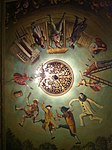Cirque d'hiver

The Cirque d'Hiver ("Winter Circus"), located at 110 rue Amelot (at the juncture of the rue des Filles Calvaires and rue Amelot, Paris 11ème), has been a prominent venue for circuses, exhibitions of dressage, musical concerts, and other events, including exhibitions of Turkish wrestling and even fashion shows. The theatre was designed by the architect Jacques Ignace Hittorff and was opened by Emperor Napoleon III on 11 December 1852 as the Cirque Napoléon. The orchestral concerts of Jules Etienne Pasdeloup were inaugurated at the Cirque Napoléon on 27 October 1861 and continued for more than twenty years. The theatre was renamed Cirque d'Hiver in 1870.The nearest métro station is Filles du Calvaire.
Excerpt from the Wikipedia article Cirque d'hiver (License: CC BY-SA 3.0, Authors, Images).Cirque d'hiver
Rue Amelot, Paris 11th Arrondissement (Paris)
Geographical coordinates (GPS) Address Website External links Nearby Places Show on map
Geographical coordinates (GPS)
| Latitude | Longitude |
|---|---|
| N 48.86337 ° | E 2.36753 ° |
Address
Cirque d'Hiver
Rue Amelot 110
75011 Paris, 11th Arrondissement (Paris)
Ile-de-France, France
Open on Google Maps










